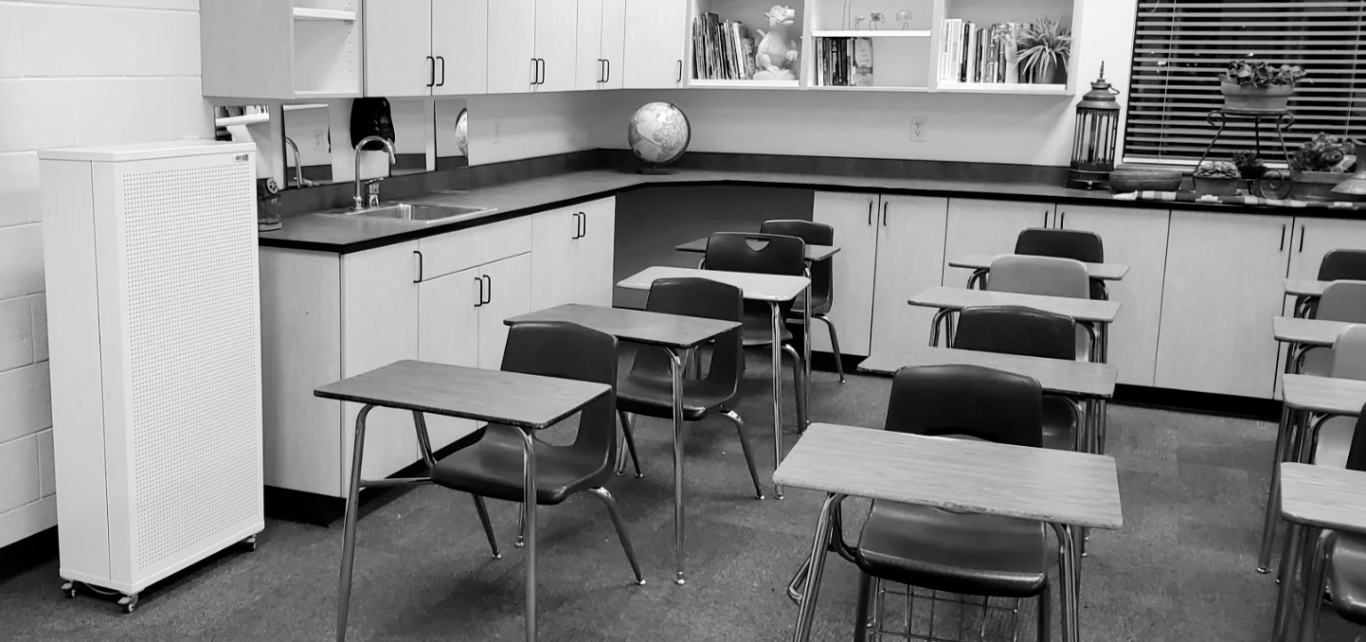.
Improving air quality inside schools
for inclusive, sustainable, equitable education
Indoor Air
Poor ventilation can cause indoor air to be 2-5 times,
even 100 times more polluted than outdoor air
Until recently, scientific research has focused on the risk of outdoor pollutants on children, from sources such as road traffic and wood burning. But, as Professor Cath Noakes states, indoor air is as important, if not more so, than outdoor air. That's because children, outside of the home, spend most of their time inside classrooms.
Indoor pollutants include fine particulate matter, mould, fungal spores & pollen, high levels of CO₂ and airborne viruses (that cause measles, flu and COVID-19). It could also include microscopic pieces of plastic.
Breathing poor-quality air is a well-documented risk to children's immediate and long-term health and cognition. Improving air quality in schools will not only reduce absence rates and safeguard children’s health and well-being; there is evidence that it will also sharpen concentration and enhance educational performance.
Safe Air Schools is a parent-led initiative, supported by experts, advocating for clean air inside classrooms. Our approach centres on inclusion, equity, sustainability and action rooted in evidence.
Explore evidence
Immediately Available, Affordable Solutions

Safe Air Schools UK have demonstrated that clean air
can be delivered with commercial air filters
per pupil, per year, for less than the price of a pizza
Pupils are physically close together in their classrooms, with a typical school having approximately four times as many occupants as an adult office space. We encourage the teaching community to use their CO₂ monitors routinely and open windows whenever possible. But air quality in densely packed classrooms cannot be reliably improved with just this strategy. Research shows 80% of air pollution inside schools comes from outside. Monitoring air quality inside classrooms is needed.
Long-term government investment in mechanical ventilation systems is the ultimate solution. In the meantime, every school can ensure a safer learning environment for students and staff by deploying portable air filters throughout their buildings. Safe Air Schools UK have demonstrated that this is affordable, and that clean air can be delivered with commercial air filters per pupil, per year, for less than the price of a pizza. Our calculations assume 30 pupils per class, 8 hours per day, and 190 working school days per year. It also includes an annual filter change per unit, with multiple units per class as needed to achieve the recommended six air changes per hour.
Commitment to Inclusivity
Schools are public spaces that should be safe and accessible to all.
Some children and staff who are immune-compromised, enduring cancer treatment or have allergies and asthma have greater risks to their health from air pollution. By advocating for safer indoor air, we will promote equitable education to safeguard our at-risk and clinically vulnerable community; leaving nobody behind.
Speaking up for Children
Young people depend on adults to keep them safe, yet the government are not addressing this major issue. We are committed to championing an education system that prioritises young people's physical as well as mental health.
Children have a right to in-person education. They need those crucial early years of educational inspiration, physical play, challenges and friendship. As parents we also want them to be there. But they must be there safely.
Campaign for Legislation
Whilst the UK has outdoor air quality guidelines, unlike the food we eat and the water we drink, indoor air pollution has no specific legislation.
We are working on the ground level with parents, teachers and individual schools but are also committed to advancing the political campaign for clean indoor air by supporting other key figures and engaging effectively with policy makers for safe and sustainable schooling. Through collaboration and dialogue, we aim to influence policies and practices that promote healthier educational environments.
















